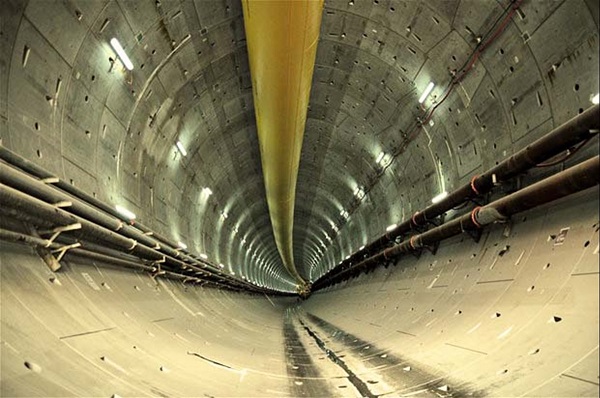The Great Istanbul Tunnel, also known as the Three-Level Grand Istanbul Tunnel, is poised to become one of the most ambitious infrastructure projects in Turkey’s history.
Designed to connect the Asian and European sides of Istanbul under the Bosphorus Strait, the tunnel aims to address the city’s chronic traffic congestion while integrating multiple modes of transportation in a single, groundbreaking structure.
A Marvel of Engineering
The tunnel’s design features a three-level structure, which is a first of its kind. The upper and lower levels are dedicated to vehicular traffic, with each level serving one direction. Sandwiched between these is a metro line that will integrate seamlessly into Istanbul’s existing and expanding rail network.
At approximately 6.5 kilometers long and built at a depth of around 110 meters below the Bosphorus, the tunnel represents an extraordinary engineering challenge, combining innovation with functionality.
Strategic Importance
Istanbul is unique as the only city in the world straddling two continents, Asia and Europe. The Bosphorus Strait, which divides the city, is a critical chokepoint for both road and maritime traffic. Currently, the city’s primary crossings include three bridges (the Bosphorus Bridge, Fatih Sultan Mehmet Bridge, and Yavuz Sultan Selim Bridge) and two tunnels (the Marmaray Tunnel for rail traffic and the Eurasia Tunnel for vehicles). Despite these options, Istanbul’s rapid urbanization and growing population of over 15 million have strained its transportation infrastructure.
The Great Istanbul Tunnel is designed to alleviate this pressure by providing an integrated, high-capacity alternative. By combining road and rail in one structure, the tunnel will significantly reduce travel times and provide an efficient solution for cross-continental commuters.
Key Features
1. Triple-Level Design:
- Road Traffic: The tunnel’s top and bottom levels will accommodate two lanes of vehicular traffic each, designed for cars and buses. This will offer a faster and more direct route for drivers traveling between the two sides of the city.
- Rail Transit: The middle level will house a metro line, forming a critical part of Istanbul’s public transportation network. This metro line will connect with existing lines, enabling seamless transitions for passengers.
2. Integrated Connections:
- On the European side, the tunnel will link to major highways like the E-5 and integrate with key metro lines, providing convenient access to urban centers.
- On the Asian side, it will connect to arterial roads and rail lines, ensuring smooth traffic flow and public transit options.
3. High Capacity and Efficiency:
- The tunnel is designed to accommodate over 6 million passengers daily, significantly easing the burden on other crossings.
- It will reduce travel times between the Asian and European sides to 15 minutes for road users and even less for metro passengers.
Environmental and Economic Benefits
1. Reducing Congestion and Pollution:
Istanbul’s bridges are notorious for long traffic jams, which contribute to air pollution and wasted time. The Great Istanbul Tunnel will divert a significant portion of this traffic underground, cutting emissions and improving air quality.
2. Boosting Public Transit:
By prioritizing rail transit, the tunnel encourages the use of public transportation, reducing reliance on personal vehicles and promoting sustainable mobility.
3. Economic Growth:
The tunnel is expected to stimulate economic activity by improving connectivity between the two sides of Istanbul. Easier access to commercial hubs will enhance trade and productivity, while the project itself generates jobs during construction and operation.
Challenges and Progress
The Great Istanbul Tunnel is a technically complex project requiring extensive planning and advanced engineering solutions. Challenges include:
- Seismic Activity: Istanbul is located in a seismically active zone, necessitating cutting-edge earthquake-resistant design and construction methods.
- Environmental Concerns: Balancing the tunnel’s construction with the need to protect the Bosphorus’ unique marine ecosystem.
As of now, the project is in advanced planning stages, with feasibility studies and tender processes ongoing. Construction timelines will depend on securing funding and overcoming logistical challenges, but the tunnel is a key part of Turkey’s Vision 2023 initiative, which celebrates the centenary of the Turkish Republic.
A Visionary Project
The Great Istanbul Tunnel is more than just an infrastructure project; it’s a symbol of Turkey’s commitment to modernization and innovation. By integrating road and rail traffic in a single structure, the tunnel sets a new benchmark for urban transportation systems worldwide.
Once completed, it will not only transform mobility in Istanbul but also stand as a testament to the possibilities of engineering and vision in bridging divides, both literal and figurative.
Also Read
Africa’s Biggest Airport Under Construction in Ethiopia: A Game-Changer for the Continent
Why Morocco’s Marrakesh Could Soon Become a Hotbed for Tourists

